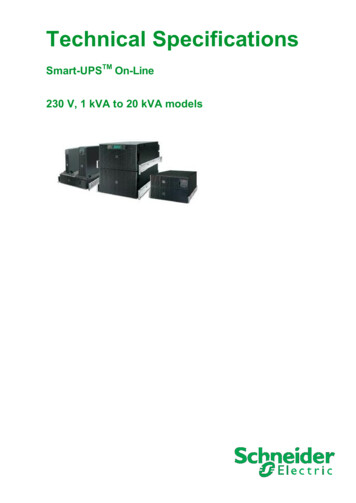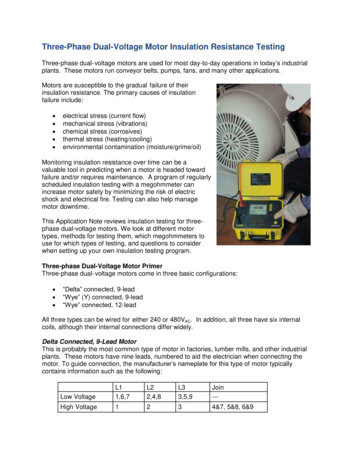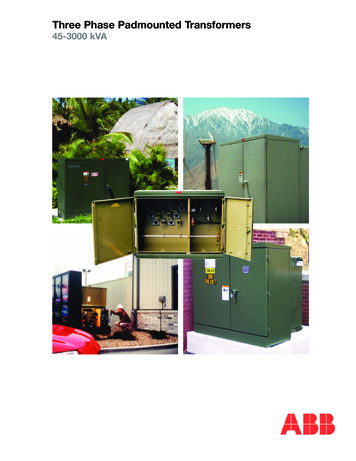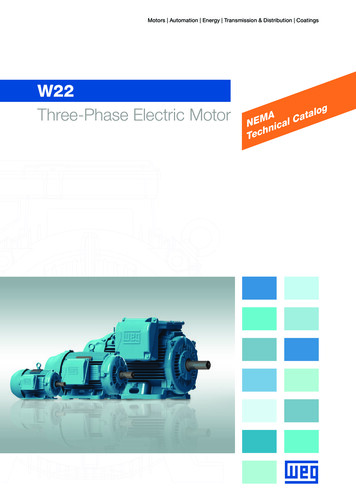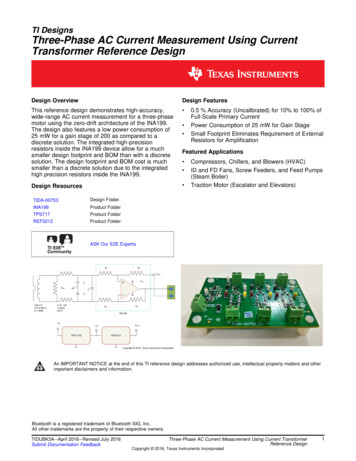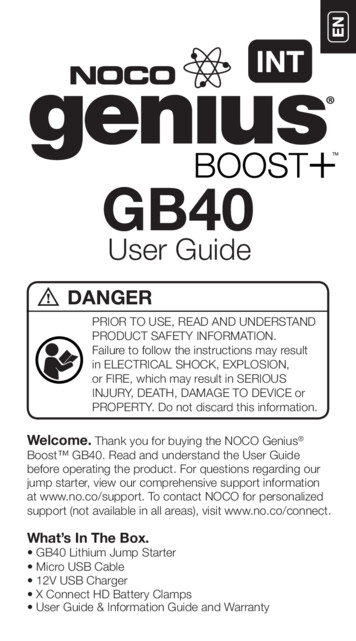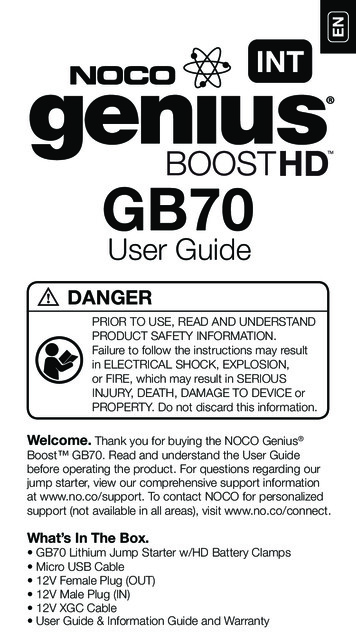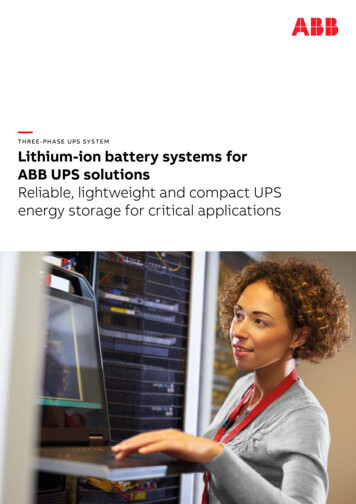
Transcription
—T H R E E - P H A S E U P S S YS T E MLithium-ion battery systems forABB UPS solutionsReliable, lightweight and compact UPSenergy storage for critical applications
2—Lithium-ion: the choice for criticalpower backup—01 For additional battery capacity, cabinetscan be installed inparallel to increasecapacity up to 5 MWper single system.When you want power protection for a data center, production line or any other type of criticalprocess, lithium-ion battery solutions providepeace of mind and the performance you need.Housed in a tough enclosure, lithium-ion batterytechnology provides reliable, lightweight andcompact energy storage for uninterruptiblepower supply (UPS) systems.Why lithium-ion?Valve-regulated lead acid (VRLA) batteries –sometimes known as sealed lead–acid batteries –have many advantages and have traditionallybeen the battery of choice for backup power inUPS systems. However, battery technology hasprogressed rapidly in recent years. Today, lithium-ion battery technology is an attractive option– especially where high energy density and lowweight are important. Advantages such as longerlifespan, smaller size and weight, shorter recharging times and falling prices – only add to the appeal of lithium-ion battery solutions.—01For best performance and lifetime, it is essentialto keep VRLA battery rooms at a reasonably constant temperature (20–25 C). Keeping thingscool can be problematic and costly, especially inhot countries. With lithium-ion batteries, thisproblem virtually disappears, as lithium-ion batteries are much more tolerant to changes in environmental temperature and can operate over abroader temperature range.Lithium-ion batteries are easy to handle too –they are safe and do not contain mercury, lead,cadmium, or other hazardous materials. In mostcases, traditional batteries would need to be replaced multiple times before a lithium-ion batteryis replaced once. When it comes to operating expenses, lithium-ion batteries offer a lower totalcost of ownership.
3—Features and benefitsOutstanding performanceFor most owners of critical applications, poweravailability is the number one priority. The powerflowing to their application simply must not fail.A lithium-ion battery system has higher reliability than a VRLA solution. Not only are the individual cells themselves inherently more safe and stable, but each battery module has an electroniccontroller that continuously checks every cell forany sign of change in performance.Single cell temperature, current, voltage andcharge status are all monitored. Monitoring alsotakes place at the cabinet level to provide a clearoverview of current battery status and to predictfuture runtime and performance.Lead-acidLithium-ionFast charge anddischarge rateCharge 0.1CDischarge 2CCharge 0.5CDischarge 6CLess spaceand weightWeight 2500 kgVolume 2 m3Weight 550 kgVolume 0.8 m3Longer life3-7 yearsExample: 190 kW power / 10 min. autonomy15 yearsLithium-ion batteries can be charged much morequickly than conventional batteries, so after usethey can be charged back up to full strength in ashorter time. This means full availability in lesstime.Lithium-ion batteries also provide higher powerdensity and efficiency, especially under heavydischarge rates. This means that no battery oversizing is needed.Low total cost of ownershipABB’s lithium-ion battery system demonstratesits commitment to delivering the best performance for the lowest total cost of ownership: Lithium-ion batteries are much more compactthan traditional batteries. This increased powerdensity means that much less real estate isneeded for the battery installation. Consideringthe cost of space in cities, in data centers or oncrowded production floors, the smaller lithium-ion battery system footprint will bring significant financial benefits. Longer battery life. With a lifetime at least double that of VRLA equivalents, lithium-ion batterycapacity costs less to buy in the long run, evenwith the attractive price of traditional batteries.The labor costs associated with battery removaland replacement are also dramatically reduced. Multiple times more discharge/recharge cyclecapability than traditional batteries means youcan use the backup facility without fear of it aging. The smaller room needed and less heat generated per ampere hour (Ah) of battery capacityresults in less need for cooling, leading to lowercosts and a reduced carbon footprint. Low weight (60–80 percent less than VRLA)means reduced civil engineering overhead andeasier physical installation.
4—01—01 Lithium-ion batteries02 Lithium-ion UPSbattery cabinetOverview of ABB lithium-ion battery systemLithium-ion battery solutions are accommodated in a standard 19” cabinet. All connectorsare front-facing for ease of installation, maintenance and replacement. A single cabinet configuration of 34.6 kWh comprises a switchgear, aswitched-mode power supply (SMPS) and 17 battery modules. Each module contains eight series-connected 67 Ah, 3.8 V cells and a dedicatedbattery management system (BMS) with cell balancing functionality. The switchgear collects allinformation about each battery cell, calculatingSwitchgearSwitched-mode power supply (SMPS)Battery modulethe state of charge (SoC) and state of health(SoH). It also contains a molded-case circuitbreaker and a shunt resistor. The SMPS suppliesthe power for the BMS and communicates withthe UPS and other connected cabinets. Batterycabinets may be connected in parallel to achievethe power needed.The battery of the futureLithium-ion battery system employs the very latestin battery technology and directly addresses thetwo top concerns of critical power users: availability and total cost of ownership. The system is aperfect fit for a wide range of ABB's UPS solutions.Working together, an ABB UPS and lithium-ion battery system provides users with the peace of mindthat their applications are protected by the verybest in power protection technology and they canbe assured a constant flow of clean power.Lithium-ion battery solutions for standbyapplications like: Data centers (e.g. co-location, control rooms) Healthcare (e.g. hospitals and medical centers) Building infrastructures (e.g. financial institutions, education centers) Transportation (e.g. railway and airport infrastructure) Manufacturing (e.g. food & beverage industry)—02Lithium-ion battery benefits: Low TCO Long lifespan High reliability Lightweight Reduced footprint and volume Wide operating temperature range Short charging time High safety level Scalable
5—Lithium ion battery system forABB UPS solutionsProduct descriptionKey features and benefits Up to 50% reducedfootprint and volume Lower rental fees andmore room for UPS'power expansion Up to 80% reducedweight Reduced civil engineeroverhead - more roomfor UPS's powerexpansion Up to 3 times higher inpower efficiency Buy what you need less battery modulesfor same powerdischarge Battery managementsystem Higher safetyprotection. Reducedmaintenance costs andrisks for unexpectedoutagesTechnical specificationGeneral dataNominal energy (kWh)34.6Capacity (Ah)67Open circuit voltage (V)516.8Operating temperature range ( C)18 - 28Charging current (A)22Type of connection2 wires / top cable entryProduct compatibilityDPA 250 S4YesConceptpower DPA 500 400 V IECYesConceptpower DPA 500 480 V ULYesConceptpower DPA 120 208 V ULYesConceptpower DPA 240 415 V ULYesPowerLine DPAYesPowerWave 33 S3YesMNS-UpYesBatteriesTypeLi-IonWeightWeight with batteries (kg)550DimensionsDimensions w h d (mm)650 x 2055 x 600 15 years designlife 10 years performancewarrantee - lower totalcost of ownership
—ABB Power Protection SAVia Luserte Sud 96572 Quartino,Switzerland Copyright 2017 ABB. All rights reserved.Specifications subject to change without notice.4NWP103899R0001 EN Copyright ABB. All rights reserved.Specifications subject to changewithout notice.04-2782 PO EN Printed in Switzerland, 2012abb.com/ups
future runtime and performance. Lithium-ion batteries can be charged much more . calculating the state of charge (SoC) and state of health (SoH). It also contains a molded-case circuit breaker and a shunt resistor. The SMPS supplies the power for the BMS and communicates with the UPS and other connected cabinets. Battery cabinets may be connected in parallel to achieve the power needed. The .
